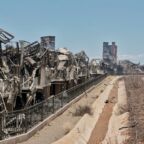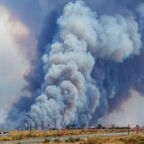Four days before the fires, the NWS issued a warning which stated that Hawaii could experience “indirect impacts” from Hurricane Dora, including “strong and gusty trade winds” and “dry weather & high fire danger.” They then issued a Red Flag Warning for areas throughout Hawaii, including West Maui. According to the NWS, a “Red Flag Warning means warm temperatures, very low humidities, and stronger winds are expected to combine to produce an increased risk of fire danger.”
Despite knowledge of these warnings, Hawaiian Electric allegedly failed to de-energize the downed lines, which has become common practice in similar scenarios. This alleged inaction led to loss of life, serious injuries, destruction of hundreds of homes and businesses, displacement of thousands of people, and damage to many of Hawaii’s historical and cultural sites.
Residents reported seeing power lines downed by the wind caused by Hurricane Dora before the fires began. The fires have been fueled by high winds, low humidity, and dry vegetation throughout the region. It was these land and atmospheric conditions that created “fire weather,” during which much of Hawaii was under a Red Flag Warning for fire risk.
“We don’t know what actually ignited the fires, but we were made aware in advance by the National Weather Service that we were in a red flag situation — so that’s dry conditions for a long time, so the fuel, the trees, and everything, was dry,” said Major General Kenneth Hara, commander general of the Hawaii Army National Guard. “That, along with low humidity and high winds, set the conditions for the wildfires.”
The winds fanning the flames were generated by Hurricane Dora, which was moving across the Pacific Ocean hundreds of miles south of Hawaii when the fires started. Dora, a Category 4 storm, caused heavy wind gusts over 60 MPH that tore through Maui, knocking down power lines and damaging homes.
For years, Hawaiian Electric had prior knowledge of the area’s fire risk. Climate change has made West Maui noticeably drier than other regions of the island, and flammable non-native vegetation has taken over the region. Hurricane winds add to the mix, a concern that had been raised after brush fires on Maui and Oahu in 2018
The wildfire lawsuits claim that Hawaiian Electric also had prior knowledge of National Weather Service’s (NWS) high wind and fire warning for Hawaii before the blazes began. NWS issued a Red Flag Warning for West Maui and other parts of the Hawaiian Islands in anticipation of “strong and gusty trade winds” during Hurricane Dora. The hurricane winds reportedly traveled up to 70 miles per hour.
Lawsuits claim these winds downed power lines, which initiated the fires and caused them to engulf Lahaina.
Because the utility company did not implement Public Safety Power Shutoffs, which California has used in its wildfire prevention strategy for years, fires grew in their intensity and consumed homes, businesses, and properties, displaced residents from their homes, and caused serious injuries and death.
The New York Times reported former member of the Hawaii Public Utilities Commission Jennifer Potter acknowledged “there should have been a requirement for them to cut off power.”
A 2018 Hawaiian Electric press release stated the utility company would apply itself to wildfire mitigation and that it had “evaluated the wildfire mitigation plans filed by the major utilities in California and studied Hawaii fire ignition maps to determine where the greatest risks are and to provide a basis for planning.”
Victim of the Maui Wildfires? | Free Consultation
If you or a loved one is a victim of the Maui Wildfires, Contact Us immediately by calling us at 808-633-8138 or by filling out an online Contact Form for a FREE Consultation.




